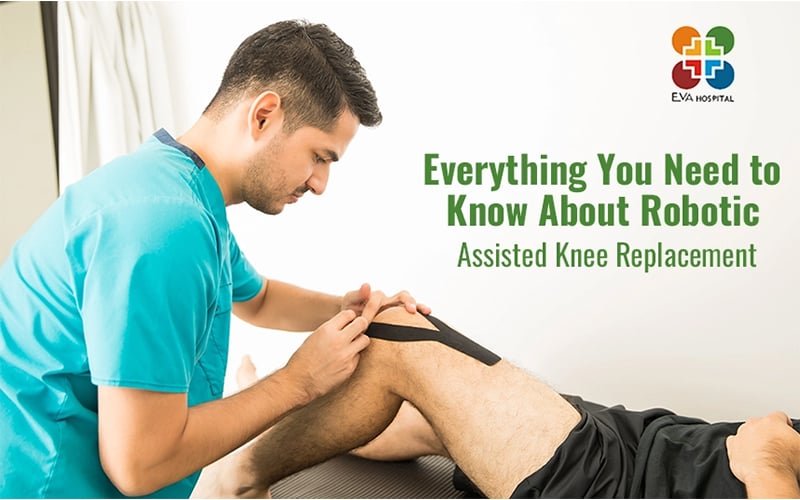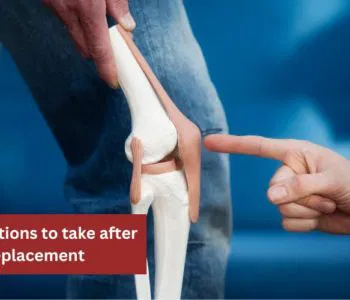Everything You Need to Know About Robotic Assisted Knee Replacement
 Eva Hospital
Eva Hospital
Everything You Need to Know About Robotic Assisted Knee…
Knee replacement surgery has become an increasingly common solution for individuals with chronic knee pain or joint damage. However, the traditional approach to knee replacement surgery can be invasive and require a lengthy recovery process. That’s where robotic assisted knee replacement comes in. This procedure has evolved to include robotic-assisted technology, which has demonstrated promising results in improving surgical precision and patient outcomes. We are proud to share that Eva Hospital is at the forefront of this innovative approach to knee replacement surgery using VELYS – the latest 4th generation Knee Robot. Read on to comprehensively understand Velys robotic knee replacement surgery and how it can benefit patients suffering from knee joint damage.
Understanding Knee Anatomy and Conditions
The knee joint is a complex structure that includes bones, cartilage, ligaments, tendons, and muscles. The three main bones that make up the knee joint are the femur (thigh bone), tibia (shin bone), and patella (kneecap). The ends of these bones are covered in a layer of smooth cartilage, which helps to absorb shock and prevent friction during movement. The knee joint also includes several ligaments that help stabilize the joint and tendons and muscles that enable movement.
Common Knee Conditions:
Several knee conditions can cause pain and dysfunction, including:
Osteoarthritis is the most common type of Arthritis and occurs when the protective cartilage in the knee joint wears down over time. Osteoarthritis can cause pain, stiffness, and reduced mobility.
Rheumatoid Arthritis: This autoimmune disease causes inflammation and damage to the synovial membrane surrounding the joint.
Post-Traumatic Arthritis can develop after a knee injury, such as a fracture or ligament tear. Post-traumatic Arthritis can cause accelerated wear and tear of the joint, leading to pain, stiffness, and reduced mobility.
Treating knee conditions may include non-surgical interventions such as physical therapy, medications, or injections. In cases where conservative treatment is impractical, robotic assisted knee replacement surgery may be recommended.
Traditional Knee Replacement vs. Velys Robotic-Assisted Knee Replacement
Traditional Knee Replacement Surgery:
In traditional knee replacement surgery, the damaged knee joint is removed and replaced with an artificial metal, plastic, or ceramic component joint. The procedure involves:
- The surgeon made an incision in the knee.
- Removing the damaged bone and cartilage.
- Attaching the new components to the remaining bone with cement or other materials.
The surgeon then closes the incision with sutures or staples.
Velys Robotic-Assisted Knee Replacement:
Velys robotic-assisted knee replacement surgery is a cutting-edge technology that uses a robotic arm to assist the surgeon during the procedure. During the surgery, the robotic arm guides the surgeon’s tools and ensures precise placement of the components. Before the surgery, the surgeon will create a plan based on the patient’s individual anatomy and needs. The robotic arm will help execute that plan with greater accuracy and precision.
The Velys robot from Johnson & Johnson is a 4th generation of robotic technology that Eva Ortho Robotics uses for knee replacement surgery. Unlike traditional robotic knee replacement surgery, Velys does not require the patient to undergo a CT scan prior to surgery. Instead, it maps the knee in real-time using ultra-high-speed hi-definition cameras and creates a robotic knee replacement plan. The surgeon then verifies the plan and, if satisfied, goes ahead with the robotic surgery.
During the procedure, the surgeon controls the robotic arm, which uses advanced sensors and cameras to provide real-time feedback and make precise adjustments. This ensures accurate placement of the joint implant and 100% accurate cuts. The robotic arm and the surgeon work together to achieve optimal results for the patient.
Advantages of Velys Robotic-Assisted Knee Replacement:
Velys robotic-assisted knee replacement surgery offers several advantages over traditional knee replacement surgery, including:
Increased Precision: In a robotic knee replacement, the robotic arm provides the surgeon with real-time feedback and assists with the precise placement of the components, which can improve the accuracy of the surgery.
Customized Treatment: The surgeon can plan and customize the surgery to each patient’s individual anatomy and needs, which can improve outcomes and reduce the risk of complications.
Faster Recovery: The precise placement of the components can lead to a faster recovery time and improved outcomes for patients.
Reduced Pain: Patients would feel reduced pain after robotic knee replacement surgery due to the precise placement of the implant and the smaller incisions used.
Improved Outcomes: Robotic knee replacement surgery result in improved outcomes for patients, including improved range of motion, reduced pain, and better overall function of the knee joint.
Wrapping Up
Robotic-assisted knee replacement is a highly effective and advanced surgical technique that can provide relief for individuals suffering from chronic knee pain or joint damage. Eva Hospital is a leading provider of orthopedic treatments, offering the most advanced and innovative techniques to improve patient outcomes. Dr Bhutani is a highly qualified and experienced orthopedic surgeon who specializes in knee replacement surgery. His compassion and dedication to patient care have earned him a reputation as one of the top-rated orthopedic surgeons in the region. If you’re considering robotic-assisted knee replacement, we welcome you to Eva Hospital!









